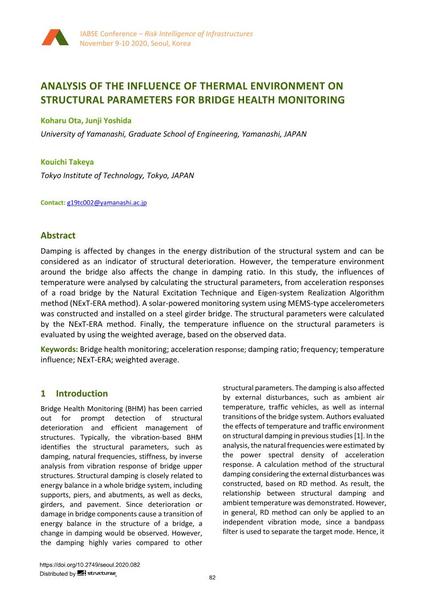Analysis of the Influence of Thermal Environment on Structural Parameters for Bridge Health Monitoring

|
|
|||||||||||
Bibliographic Details
| Author(s): |
Koharu Ota
(University of Yamanashi, Graduate School of Engineering, Yamanashi, JAPAN)
Junji Yoshida (University of Yamanashi, Graduate School of Engineering, Yamanashi, JAPAN) Kouichi Takeya (Tokyo Institute of Technology, Tokyo, JAPAN) |
||||
|---|---|---|---|---|---|
| Medium: | conference paper | ||||
| Language(s): | English | ||||
| Conference: | IABSE Conference: Risk Intelligence of Infrastructures, Seoul, South Korea, 9-10 November 2020 | ||||
| Published in: | IABSE Conference Seoul 2020 | ||||
|
|||||
| Page(s): | 82-89 | ||||
| Total no. of pages: | 8 | ||||
| DOI: | 10.2749/seoul.2020.082 | ||||
| Abstract: |
Damping is affected by changes in the energy distribution of the structural system and can be considered as an indicator of structural deterioration. However, the temperature environment around the bridge also affects the change in damping ratio. In this study, the influences of temperature were analysed by calculating the structural parameters, from acceleration responses of a road bridge by the Natural Excitation Technique and Eigen-system Realization Algorithm method (NExT-ERA method). A solar-powered monitoring system using MEMS-type accelerometers was constructed and installed on a steel girder bridge. The structural parameters were calculated by the NExT-ERA method. Finally, the temperature influence on the structural parameters is evaluated by using the weighted average, based on the observed data. |
||||
| Keywords: |
frequency bridge health monitoring Damping Ratio acceleration response temperature influence NExT-ERA weighted average
|
||||
